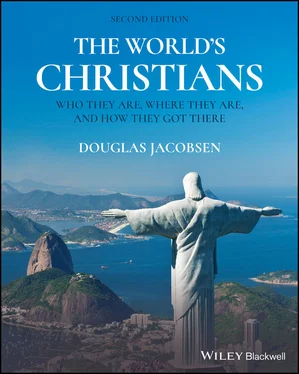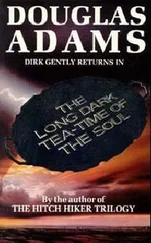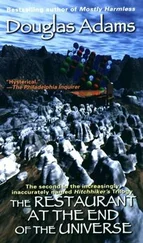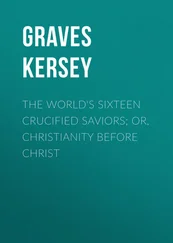1 ...6 7 8 10 11 12 ...33 All four of these four mega‐traditions have numerous sub‐traditions within them. This is most obvious within Protestantism where the different sub‐traditions (or “denominations”) have names like Baptist, Lutheran, Methodist or Presbyterian. But a similar internal diversity exists within the other mega‐traditions, including Catholicism where, for example, Catholics oriented toward Jesuit ideas and practices may differ considerably from Catholics oriented toward Benedictine, Dominican or Franciscan ideas and values. While it is important to be aware of this internal variety within the four mega‐traditions, the focus here will be on what distinguishes Orthodox Christians, Catholics, Protestants, and Pentecostal Christians from each other, not on these smaller sub‐traditions.
A handful of Christian groups do not fit neatly into any of these four traditions. For example, about half a million Christians belong to an ancient tradition known as the Church of the East. In the year 700, the Church of the East was one of Christianity’s mega‐traditions and comprised about a quarter of the world’s Christian population, but its size and influence has diminished over the centuries. The Church of Jesus Christ of Latter Day Saints (LDS), sometimes known as Mormons, is another Christian group that exists outside the four mega‐traditions of Orthodoxy, Catholicism, Protestantism, and Pentecostalism. Founded in the nineteenth century, the LDS affirms several unique beliefs about God and the historical Jesus that set it apart from other Christian churches. There are more than sixteen million Mormons worldwide, making them much larger than today’s Church of the East, but in global perspective the LDS Church is still only a very small movement, accounting for less than 1 percent of all Christians globally.
Within the overarching category of being Christian, most Christian individuals see themselves as belonging to one and only one of the four contemporary mega‐traditions. Typically, a person is either Orthodox or Catholic or Protestant or Pentecostal. But while this general rule of thumb rings true for most Christians, there is sometimes fuzziness at the boundaries between these groups. For example, some people think of themselves as both Orthodox and Catholic because they are members of Catholic Churches that use an Orthodox (or “eastern rite”) liturgy for worship. Other Christians consider themselves to be both Catholic and Protestant, most notably “Anglo‐Catholic” members of the Church of England.
This mixing of Christian identities is especially common at the borders where the Pentecostal tradition touches the Protestant and Catholic traditions, and there are literally millions of Christians who consider themselves to be both Catholic and Charismatic, or both Protestant and Pentecostal, at the same time. These overlapping identities contribute to the complexity of counting the numbers of Christians who belong to each of the four traditions. In the population numbers that appear in The World’s Christians half of these doubly oriented Christians have been assigned to the Pentecostal category and half have been counted as members of the other tradition that defines their dual Christian identity (either Catholic or Protestant).
Each of the four contemporary Christian mega‐traditions had a beginning point, but the particular date of birth is not always easy to identify. The Pentecostal movement is the youngest and easiest to date. Most historians associate the birth of this tradition with the Azusa Street Revival, which took place in Los Angeles, California from 1906 to 1908. The Protestant movement is the next youngest, and its birth date is sometimes given as October 31, 1517, the day when Martin Luther issued his famous 95 Theses protesting the practices of the Roman Catholic Church. The origins of the Catholic and Orthodox traditions are more difficult to date with precision. They claim the same ancient roots in the early church, and the two traditions only slowly diverged from each other over the centuries. The Orthodox tradition acquired its distinctively Orthodox shape around the ninth century, while the Catholic tradition developed its decisively Catholic identity during the eleventh through the thirteenth centuries.
The following chapters describe these four mega‐traditions and use a similar outline for each. First, the spirituality (the core convictions and lived experience) of believers is described; second, the specific understanding of salvation is explained; a third section focuses on the structure of the tradition, the movement’s institutional and sociological organization; and a final section provides a brief outline of the story (or history) of the tradition. Taken together, these four chapters provide a basic answer to the question, “Who are the world’s Christians?”
Orthodoxy has the longest history of the four major Christian traditions that exist today, and it preserves the ancient ideas and practices of Christianity more fully than any other tradition. In many ways, the past is still alive in Orthodoxy, so much so that some outsiders view Orthodoxy as locked in the past. But for its adherents, Orthodox Christianity is very much a living faith, connecting them to the present and future as much as to the past. Geographically, the original heartland of Orthodoxy was the Middle East and the Balkans (the area of land located south of the Danube River). By 1500, however, under increasing pressure from Islam, the geographic center of Orthodoxy had moved north into Russia and Eastern Europe, where Orthodoxy remains the majority religion today (see Figure 1.1).
Theologically, Orthodoxy can be divided into two distinct sub‐traditions. The Eastern Orthodox Church, which accounts for about 85 percent of all Orthodox Christians, is sometimes known as the church of the seven councils because it affirms all seven of the early “ecumenical councils” (worldwide gatherings of Christians called to decide what Christians should believe) that were held between the years 325 and 787. A second, smaller sub‐group of churches known as the Oriental Orthodox or Miaphysite churches (including the Armenian Apostolic Church, the Coptic Orthodox Church, the Ethiopian Orthodox Church, and the Syrian Orthodox Church) rejected the conclusions of the Council of Chalcedon (held in the year 451) and have remained institutionally separate from Eastern Orthodoxy ever since. In the 1960s, representatives from these two different Orthodox sub‐groups (Eastern Orthodoxy and Oriental Orthodoxy) began a dialogue seeking reunification, but that desired reunion has not yet taken place.
One of the historical experiences that makes Orthodox Christianity different from the other three Christian mega‐traditions is that Orthodox Christians have been marginalized and oppressed more than most Christians. Since the seventh century (the 600s) many Orthodox Christians have lived in regions of the world ruled by Islamic governments where their religious rights have been limited. In the twentieth century, Orthodox Christians suffered greatly when Communists assumed control of Russia in 1917 and subsequently all of Eastern Europe following World War II. This history of social marginalization, mixed occasionally with outright persecution, has tended to make Orthodox Christians more communally minded than other Christians. To be Orthodox has often been a marker of peoplehood in addition to being an affirmation of faith.
The spirituality of Orthodoxy focuses on worship, and to enter an Orthodox church is to enter a different place and time. The Orthodox liturgy (the Orthodox worship service) is seen as a way of participating briefly in the eternal worship of God that is always taking place in heaven, and Orthodox churches are designed to communicate this message. Many Orthodox churches have domed ceilings, and at the top of the dome there is an opening called the oculus . This is a symbolic eye into heaven. A huge picture of Christ as Pantokrator (the ruler of all) is painted in the oculus, surrounded by angels and apostles, looking down on the gathered congregation (see Figure 1.2). In traditional Orthodox worship, everyone stands for the entire service as a way of showing respect to God, but many Orthodox churches (especially in the United States) have now installed pews so people can sit down during worship.
Читать дальше












